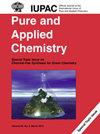通过在发展中国家推广生物质甲烷化使我们的环境脱碳:一种废物管理工具
IF 2
4区 化学
Q3 CHEMISTRY, MULTIDISCIPLINARY
引用次数: 0
摘要
长期以来,化石燃料一直是我们日常生活的一部分,并不断导致二氧化碳(CO2)排放到环境中。甲烷(CH4)释放到我们周围的原因可能是我们日常活动中产生的有机废物的分解;人类活动产生的 CH4 造成了至少 25% 的全球变暖。CH4 是一种已知的强效温室气体,其捕获的热量约为 CO2 的 35 倍。这些温室气体在气候变化和全球变暖中发挥着作用。因此,探索环境脱碳措施变得非常重要。利用我们产生的废物生产生物甲烷是一种很有前景的脱碳方法,在减少温室气体排放方面具有巨大潜力。本文概述了潜在的生物质甲烷化原料,并研究了几种技术,如厌氧消化、热解和甲烷化联合技术以及气化和甲烷化联合技术。对废物转化为生物甲烷进行了 SWOT 分析,并概述了与扩大生物甲烷生产工艺有关的要点。此外,还对促进生物质甲烷化应用的前景提出了见解。总之,生物质甲烷化在生产可持续能源方面具有巨大潜力。因此,工业家、研究人员、政府机构和利益相关者之间的合作,包括对财政投资、投资回报或潜在补贴和激励措施的了解,可以提高拟议解决方案的实用性。应持续开展研发工作,因为这是扩大和推广技术所必需的。此外,还应为利益相关者提供技术培训,因为这对该行业的顺利发展至关重要。本文章由计算机程序翻译,如有差异,请以英文原文为准。
Decarbonizing our environment via the promotion of biomass methanation in developing nations: a waste management tool
For a long time, fossil fuel has been a part of our everyday lives and has constantly led to the emission of carbon dioxide (CO2 ) into the environment. The release of methane (CH4 ) into our surroundings can be caused by the decomposition of organic wastes produced by our daily activities; CH4 produced by human activity is responsible for at least 25 % of global warming. CH4 is a known potent greenhouse gas that can trap about 35 times more heat than CO2 . These greenhouse gases play a role in climate change and global warming. It, therefore, becomes important to explore measures for decarbonizing our environment. Biomethane production using our generated waste is a promising decarbonization approach with significant potential for mitigating greenhouse gas emissions. This paper overviews potential biomass methanation feedstocks and investigates several technologies, such as anaerobic digestion, combined pyrolysis and methanation, and combined gasification and methanation. SWOT analysis of waste conversion to biomethane was conducted, and important points related to the scaling-up of biomethane production processes were outlined. Also, insights into prospects for promoting biomass methanation deployment were provided. In conclusion, biomass methanation has great potential for producing sustainable energy. Hence, collaboration between industrialists, researchers, government agencies, and stakeholders including an understanding of the financial investments, return on investments, or potential subsidies and incentives could enhance the practicality of the proposed solution. Research and development should be continuously carried out as they are necessary to scale up and promote the technology. Also, there should be technical training for stakeholders as it is essential for the smooth development of the sector.
求助全文
通过发布文献求助,成功后即可免费获取论文全文。
去求助
来源期刊

Pure and Applied Chemistry
化学-化学综合
CiteScore
4.00
自引率
0.00%
发文量
60
审稿时长
3-8 weeks
期刊介绍:
Pure and Applied Chemistry is the official monthly Journal of IUPAC, with responsibility for publishing works arising from those international scientific events and projects that are sponsored and undertaken by the Union. The policy is to publish highly topical and credible works at the forefront of all aspects of pure and applied chemistry, and the attendant goal is to promote widespread acceptance of the Journal as an authoritative and indispensable holding in academic and institutional libraries.
 求助内容:
求助内容: 应助结果提醒方式:
应助结果提醒方式:


